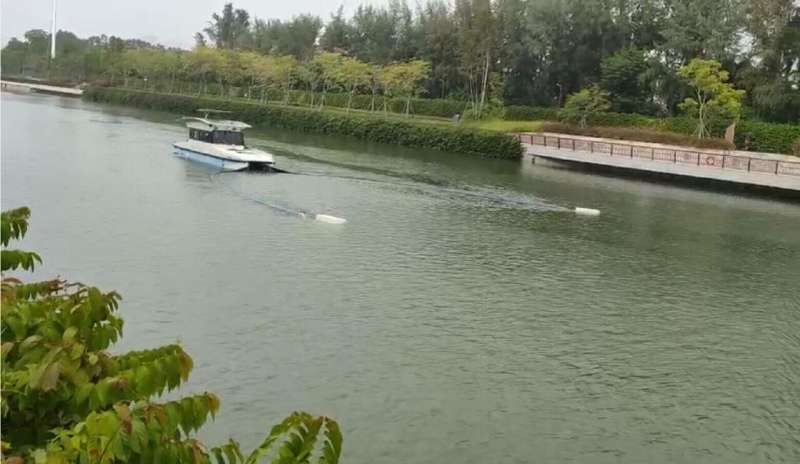Wing vehicle system collects garbage on water more efficiently

Researchers have developed an unmanned intelligent cleaning vehicle system that has a salvage range 10 times larger than traditional cleaning vehicles.
“The system can significantly improve work efficiency, reduce labor costs and meet cleaning needs,” said Dr. Yu Daoyang from the Hefei Institutes of Physical Science of the Chinese Academy of Sciences, who led the team.
Environmental problems of water area are becoming increasingly prominent. Many water-cleaning robots have been invented to clean floating garbage. However, conventional unmanned surface vehicles can only collect garbage up to three meters in width. More efficient ways of doing this work are needed.
This unmanned surface vehicle system is composed of a main vehicle (10m in length) and two pilot sub-vehicles (0.8m in length). It’s like a bird with two wings.
During operation, two sub-vehicles pull the main vehicle with garbage racks. The extension forms a trumpet-shaped garbage collection area of about 30 meters in width to collect all the garbage in the area.
Seven months ago, the team developed an unmanned cleaning boat. This time the key point is to make the three independent vehicles cooperate. They proposed an adaptive process identification control method and geometric approximation algorithm for multi-objective coordination. By using this method, autonomous control of the navigation path of the sub-vehicles was realized. The main and two sub-vehicles can also navigate cooperatively.
In addition, several operation modes such as river approach, river central driving, autonomous cruise and obstacle avoidance mode are available. These modes can be switched freely according to the site conditions. All operation modes are centered around the main vehicle.
In obstacle avoidance mode, for example, the “wing” team will decide whether to overtake, follow or slow down by taking reasonable obstacle avoidance measures according to the situation they encounter. This way, each boat knows where it should be, and formation can be maintained even through a combination of current, wind, and longitudinal traction.
“The cleaning efficiency is much far higher than conventional surface vehicles,” said Yu.
Novel intelligent vehicles to monitor water source safety for 2022 Winter Olympic Games
Citation:
Wing vehicle system collects garbage on water more efficiently (2022, January 13)
retrieved 13 January 2022
from https://techxplore.com/news/2022-01-wing-vehicle-garbage-efficiently.html
This document is subject to copyright. Apart from any fair dealing for the purpose of private study or research, no
part may be reproduced without the written permission. The content is provided for information purposes only.
For all the latest Technology News Click Here
For the latest news and updates, follow us on Google News.

